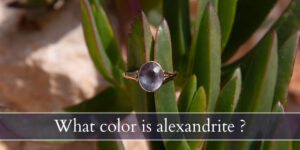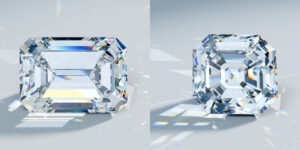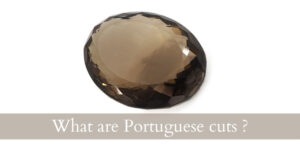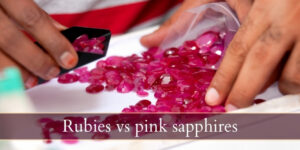Purple gemstones are quite rare, and if you’re looking for another purple gem that is not an amethyst, it’s not very easy to find them. Fortunately many gems come in more than one color, and some of them also come in purple !
Today we’re taking a look at the most common purple gemstones and how well they’d behave in jewelry.
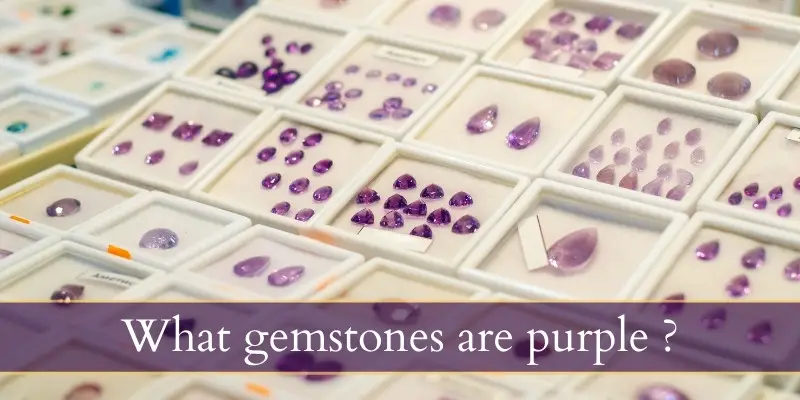
What gemstones are purple ?
The first gemstone that comes to mind when looking for a purple gem is amethyst. But there are so, so, many other gems you could use in place of amethyst, some of the stronger, some of them a deeper shade of purple, or simply a different gem altogether.
Finding purple gems is possible, it’s easier than finding orange ones. But you have to be a bit flexible on the exact shade, as not all gems are a bright, saturated purple. Some are a soft lilac, some come in very dark violet, and some tread between blue and purple.
Now let’s take a look at what you’re likely to find when looking for a purple gemstone. This list will take into account color, Mohs hardness score, and price ranges, in no particular order.
1. Purple diamonds
Purple diamonds are a type of fancy diamond, which is simply shorthand for ‘diamonds that are not clear’. Any diamond that exhibits color is classed as a fancy diamond, simply to make it easier to distinguish between the usual clear diamond and the colorful ones.
So a purple diamond is still a diamond. It’s a very tough stone (10 on the Mohs scale) and it still sparkles. Lighter tones ones, so lilac diamonds, will sparkle a bit better than the darker or more vivid purple diamonds.
You’ll usually find purple diamonds for an average of $100,000 per carat, and most of them are on the pale side. There are darker, more intense purple diamonds but they’re quite rare nd can get to double the initial price. An interesting point is that you won’t easily find purple diamonds above 1 carat. So if you’re looking to get a large gem, consider a cluster or halo setting.
Read also: Fancy Cut Diamonds Exaplained
2. Purple sapphires
Sapphires come in various shades of purple and they manage to outclass purple diamonds in terms of color. They don’t sparkle as much, of course, but they make up for it through color. You can find purple sapphires form the palest lilac to the darkest violet, with red or blue hues or truly neutral purples. Really, it looks like purple sapphires are the purple gem to end all purple gems.
You can find purple sapphires for an average of $6,000 per carat for the vivid color, eye-clean ones, and about $4,000 per carat for the lighter colors or the ones with visible inclusions.
Purple sapphires are still sapphires so they are very tough, scoring a 9 on the Mohs scale. This makes them excellent for everyday wear such as an engagement ring or a tennis bracelet.
3. Amethyst
Amethysts are the most famous purple gem, in fact they are THE purple gem everyone thinks of when they say they’d like a purple gemstone as their center stone or to have at home. Well, amethysts are a variety of quartz, and they are a bit fragile because of this. Quartz scores a 7 on the Mohs scale and as such it might be best to restrict it only to occasional wear or a safe setting such as a pendant or a pair of earrings.
In terms of color amethysts are a beautiful shade of purple and they vary from light purple to very dark purple. Most of the time the color is a neutral violet, but you can find some specimen that have a red or blue undertone.
In terms of price amethyst is actually very affordable. It lost its precious gemstone standing when a large deposit was found in Brazil a century ago, so it’s been quite affordable ever since. How much ? About $7 per carat for an eye-clean, vivid color, on average.
4. Purple garnet
Garnets are well known for their red color, but did you know they can also be purple ? A reddish purple, so you’ll have a difficult time finding a purple garnet with a blue undertone, but it’s still a very beautiful color. They’re also pretty tough, averaging an 8 on the Mohs hardness scale, so they could be worn every day but you should expect to re-polish them every few years.
You can find these garnets labeled as rhodolite, or Mozambique garnets as that’s the most famous location for these garnets. Purple garnets usually sell for an average of $45 per carat.
5. Iolite
This gemstone isn’t as well known as other purple gems, or even other gems in general. But iolite can offer you that deep purple shade you’re looking for, especially if you prefer a blue undertone to your purple. Iolite is usually very clear, so it may appear a bit lighter in color when you look at larger specimens. A better way to explain their color would be the blue-purple you can see on some hyacinths.
Iolites are not the toughest gems, as they score a 7 on the Mohs scale. This puts them in the same situation as amethysts: handle with care, and maybe don’t set in a ring or bracelet. You can find iolite at about $13 per carat, which is quite affordable, especially if you’re only looking for occasional wear.
6. Kunzite
Kunzite is a beautiful gem that simply treads between pink and purple. It’s incredibly light in color and it’s also eye-clean all the time, so it works best for those looking for a soft, light shade of purple with a pink undertone.
This gem usually sells for $22 per carat, and it never gets to a very vivid color. Because of its high clarity and it’s softness (6.5 on Mohs scale) kunzite will readily pick up and accumulate scratches and it will be very noticeable. Use this gem in a pendant or a pair of earrings if you want it to last.
7. Purple tourmaline
Purple tourmaline is very easy to confuse with pink tourmaline, and for good reason. Like purple garnet purple tourmaline has a red undertone that means it walks the fine like between purple and pink. Still purple tourmaline is a beautiful gemstone that is very easy to find and quite abundant.
You can find purple tourmaline for an average of $34 per carat. As for wearability this gem scores 7-7.5 on the Mohs scale, which is still pretty easy to scratch. Like amethyst and iolite, you should consider wearing purple tourmaline only occasionally or with very much care.
8. Tanzanite
Tanzanite is up for debate in this case. It’s more of an indigo gemstone, or rather a purple with really strong blue undertones. It has a beautiful color and they very clear one resemble a bluish amethyst or iolite. Overall a really nice gem if you’re looking for a blue-toned purple. It might be too blue for some, so it depends on your tastes.
In terms of price you can find tanzanite for an average of $9 per carat, so it’s right up there with iolite and amethyst in terms of pricing. Unfortunately this gem averaged a 6.5 on the hardness scale, so it should definitely be worn as a pendant or a pair of earrings, otherwise it will simply scratch way too much.
What metal do purple gems go with ?
Purple gemstones go very well with white metals or yellow ones, as the white metals offer a nice neutral color to let the purple shine, while the yellow metals offer a beautiful contrast to the purple. Yellow gold and reddish purple work especially well together.
Rose gold may not be a good idea for a purple gemstone, because it can compete too much with the purple. This is very similar with wearing blue and green together, or yellow and orange. It’s difficult to pull off so it’s best to not attempt it.
If you’re considering a halo for your purple gem, keep in mind that white gems work best. Or, if you’re feeling adventurous you can try light yellow or beige gems (like champagne diamonds or pale citrines).

I’m the main author for jewelrymaterialguide.com. I started this site after we did tons of research before our wedding and noticed that there is information about rings, jewelry, and so on that is really hard to find on the internet.

